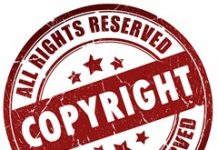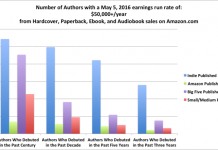![]()
Shelf Awareness has a summary of Apatara’s third annual ebook survey, and the above headline is one of the points they call out.
How publishers are adapting was the focus of another recent study. One out of five e-book publishers generates more than 10% of sales from e-books, indicating that the segment still has substantial room for growth, according to Aptara’s third annual e-book survey of 1,350 publishers from the trade, education, professional and corporate markets.
More than any other publishing segment, trade has most embraced e-books: the percentage of trade publishers producing e-books rose from 50% to 76% in two years. Another 19% of trade respondents indicated they have plans in place for e-book production. Only 6% said they are not planning for e-books in the foreseeable future, a 17% drop from Aptara’s first survey.
All segments expressed uncertainty about which sales channel is the most lucrative for their e-books. According to the survey, the choices of “Unsure” and “Other” ranked as the third-highest response options. Of the comments generated under “Other,” most reported that e-book sales are still very young, or pending, Aptara noted, adding that this lack of clarity surrounding a basic business metric like revenue source suggests that most publishers’ e-book operations are still in their infancy.
The survey found that publishers still rely most heavily on Amazon for distribution, but the percentage (18%) is steadily declining due to the proliferation of other platforms and channels, particularly ePub-based. But a rapidly expanding e-book sales and distribution market is making the pie bigger for all concerned.
As for specific devices, the PC/Mac category at 19% leads by the narrowest of margins over Kindle (18%), followed by “Single-function ePub devices” (15%) and Apple iBookstore (15%). Since this survey question allowed for multiple selections, Aptara found that when “Single function ePub devices” was combined with “Apple iBookstore (ePub)” responses, ePub’s emerging dominance was more apparent, with Kindle selected 18% of the time and ePub 30%. Of all the publishing market segments, trade has the widest ePub-to-Kindle margin at 34% to 19%.
Although Amazon generates significantly more e-book sales than ePub-based platforms and devices, Aptara suggested that publishers are preparing for an increase in the adoption of ePub, possibly concurrent with the introduction of ePub 3, and anticipating alternate ePub-based distribution channels.
Two out of three e-book publishers have not converted the majority of their backlist titles to e-books.
In response to the big survey question–“Are/will your eBooks be produced primarily in place of, or in addition to, print editions?”–publishers were nearly unanimous, with 85% across all market segments saying they are producing print as well as e-book versions of their titles.
Looking to the future, Aptara observed: “Publishers couldn’t ask for a better position: the ground floor of an early-stage market experiencing exponential sales growth. The downside to being at the starting gate is the growing pains; the upside is the untapped revenue potential that lies ahead.”
If you don’t subscribe to Shelf Awareness‘ daily email, you really should.


































“Since this survey question allowed for multiple selections, Aptara found that when “Single function ePub devices” was combined with “Apple iBookstore (ePub)” responses, ePub’s emerging dominance was more apparent, with Kindle selected 18% of the time and ePub 30%.”
Of course since AdobePub Classic and New AdobePub are only semi-mutually compatible, and neither is compatible with ApplePub this statement is rather misleading. Add in the fact that both Classic and New AdobePub (although not ApplePub) and .AZW can be trivially converted to other formats and the picture becomes even less clear.
I can’t help but be amazed at the ‘dragging-my-feet’ mentality regarding getting as many eBooks out as possible, a notion that most widget businesses embrace fully in order to maximize product exposure and sales. It’s as if publishers are so resistant to change that they want everyone else to “go first” before they’ll stick their proverbial toe in the eWater, and even it only appears to be a half-hearted effort. I may only be a self-published eWriter but I know that’s not the way to make money; sometimes you have to go all in or go home.
The average consumer can sense this hesitation from the big publishing companies and more and more are seeking other ways to get the eBooks they want, from indie publishers and self-pubbers that: 1. charge reasonable rates, 2. keep providing new content and 3. listen to their customers.
Backlist conversion are a pain to do correctly, because it starts with an OCR scan. It takes some careful proofing to clean up the scan errors, and even then you’ll end up with some errors left in.
There often are contracting issues. In many cases the rights reverted to the author a short time after the book went out of print, and even if there’s still a current contract, it probably doesn’t mention e-book rights. There’s also the need to come up with cover art and such.
For all of that effort, sales of backlist titles are usually very low, often measured in the dozens or hundreds at best. Most readers who had any interest have already read and/or bought those titles. The relatively few people who are still interested in acquiring a copy will find used paperbacks to be far less expensive… if they cared enough to be willing to pay a new-book price, they probably wouldn’t be in this “never did get around to reading it” group.
The most attractive backlist titles are early books in a still-current series. The publisher can give away the first book or two to get interest in the series, or can look for the “pop” in backlist sales when each new book in the series is released.
“For all of that effort, sales of backlist titles are usually very low, often measured in the dozens or hundreds at best. Most readers who had any interest have already read and/or bought those titles. ”
Is this really a statement of fact ? or a historical statement that used to apply to paper books but is now out the window because the world of eBooks is a totally new ball game ?
Fact, Howard. Remember, most of the backlist titles weren’t big sellers to begin with. According to Publishers Weekly from 2006, “The average book in America sells about 500 copies.” http://parapublishing.com/sites/para/resources/statistics.cfm A book that sold 500 copies to begin with isn’t going to sell a lot of copies in e-book.
In addition, many of the backlist titles simply look tired today. Writing styles change. In addition, anything written “contemporary” even 15 years ago probably uses pay phones rather than cell phones. From 20 years ago, no Internet.
There are a few publishers like Open Road and RosettaBooks that are trying to make money e-publishing the old block-buster novels; the ones that sold millions of copies in print. RosettaBooks recently reported that sales of five of their big titles — The Graduate, Midnight Cowboy, A Passage to India, Shoeless Joe, and Red Alert — totaled less than 250 copies during the month of April… and that’s for all five titles combined. The Graduate alone had sold over 2 million copies in print. http://www.rosettabooks.com/eReader-Independent/when-free-successful-business-strategy
Some carefully chosen titles can do well, but overall, backlist e-books are a money pit and not a gold mine.
It is only a historical fact, not a current one applying to eBooks because a backlist market has not been established.
Using averages is a mugs game that hides more than it illuminates. No one anywhere is expecting every backlisted book from every year of publishing to be converted.
As to being tired or dated, I see no relevance for this. Period fiction is a popular genre and I don’t here much complaint about there being no phones or cars or washing machines in those titles. Goof writing doesn’t need to be technologically contemporary. Good stories are timeless.
So it is hugely premature to expounding on what the potential of backlist titles will be.
The biggest challenge they have is similar to the challenge every current titles has in eBook form – that of exposure. How are readers going to find titles in the eBook age. But we just don’t know how that is going to pan out yet. It is too early. Social reading sites are innovating every week. New reviewing models are also innovating.
All it takes is the development of great new business models for bringing good titles to the attention of interested readers, and the exposure problem will be solved or at least partially solved.
It would be interesting to know where the “dozens or hundreds at best” figure comes from. (Even if it’s not a source that can be looked up online).
Howard: if you look at the music business, there was a lot of optimism about “the long tail” that doesn’t seem to have gone anywhere.
http://www.theregister.co.uk/2008/11/07/long_tail_debunked/
Music had the advantage of already being digitized for CD.
I’m also generically sceptical about assumptions that technology will come along and make everything better _in time to justify a certain position_. E-reading took what, ten years to be popularized, with several failed investments, including by publishers.
If someone thinks they can make a go of it, there should be at least enough good s.f. backlist to get the ball rolling. The flip side of the announcement is that a third (400+) _have_ converted over half their backlist to e-books… that’s not very conclusive, but it sounds promising.